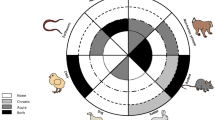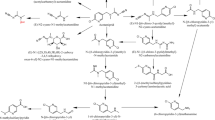Abstract
A laboratory toxicity study on house mice and laboratory mice (Mus musculus), gray-tailed voles (Microtus canicaudus), and deer mice (Peromyscus maniculatus) was conducted as part of a comprehensive laboratory and field study to field validate laboratory-based risk assessment of pesticides. The single dose oral LD50 for the organophosphorus insecticide azinphos-methyl (Guthion®) was 10, 11, 32, and 48 mg/kg body weight in wild house mice, laboratory mice, gray-tailed voles, and deer mice, respectively. Ten-day dietary LC50s were 277 ppm for laboratory mice, 297 ppm for gray-tailed voles, and 1,180 ppm for deer mice. All treated animals lost more weight, consumed less food, and had depressed brain cholinesterase (ChE) activity compared to controls. Five-day LC50s were significantly higher than 10-day LC50s for laboratory mice and deer mice. For all three species, animals that died during dietary LC50 tests had mean ChE activity of 50–55% while survivors had 56–70% of controls. The conclusions were that: (1) Laboratory mice were not representative of deer mice or gray-tailed voles with respect to sensitivity to azinphosmethyl, but provided a conservative estimate for risk assessment; (2) 10-day dietary LC50 tests indicate substantially greater estimates of toxicity of azinphos-methyl to rodents than do 5-day tests; and (3) brain ChE depression of 45–50% was lethal in these species.
Similar content being viewed by others
References
Blus LJ, Staley CS, Henny CJ, Pendleton GW, Craig TH, Craig EH, Halford DK (1989) Effects of organophosphorus insecticides on sage grouse in southeastern Idaho. J Wildl Manage 53:1139–1146
Gad SC, Chengilis CP (1988) Acute toxicology testing. Telford Press, Caldwell, NJ
Cholakis JM, McKee MJ, Wong LCK, Gile JD (1981) Acute and subacute toxicity of pesticides in microtine rodents. In: Lamb DW, Kenaga EE (eds) Avian and mammalian wildlife toxicology: Second conference. Am Soc Test Mater Spec Tech Pub 757, Baltimore, MD, pp 143–154
Fairbrother A, Bennett JK, Marden B, Hooper MJ (1990) Methods of cholinesterase analysis, a United States perspective. In: Mineau P (ed) Cholinesterase-inhibiting insecticides. Elsevier, Amsterdam, pp 35–72
Fairchild EJ (1978) Agricultural chemicals and pesticides. Castle House, London
Falconer DS (1981) Introduction to quantitative genetics. Longman and London, New York, 340 pp.
Grue CE, Fleming WJ, Busby DJ, Hill, EF (1983) Assessing the hazards of organophosphate pesticides to wildlife. North Am Wildl Natur Resour Conf 48:200–219
Hill EF (1993) Acute and subacute toxicology in evaluation of pesticide hazard to avian wildlife. In: Kendall RJ, Lacher TE Jr (eds) Wildlife toxicology and population modeling: Integrated studies of agroecosystems. Lewis Publ., Inc, Chelsa, MI, pp 219–238
Hoerger FD, Kenaga EE (1972) Pesticide residues on plants. Correlation of representative data as a basis for estimation of their magnitude in the environment. In: Coulston F, Korte F (eds) Environmental quality and safety. Academic Press, NY, pp 9–28
Linder G, Richmond ME (1990) Feed aversion in small mammals as a potential source of hazard reduction for environmental chemicals: Agrichemical case studies. Environ Toxicol Chem 9:95–105
McCann JA, Teeters W, Urban DJ, Cook N (1981) A short-term dietary test on small mammals. In: Lamb DW, Kenage EE (eds) Avian and mammalian wildlife toxicology: Second conference. Am Soc Test Mater Spec Tech Pub 757, Baltimore, MD, pp 143–154
National Research Council (1983) Risk assessment in the federal government: managing the process. National Research Council. National Academy Press, Washington, DC
Rattner BA, Hoffman DJ (1984) Comparative toxicity of acephate in laboratory mice, white-footed mice, and meadow voles. Arch Environ Contam Toxicol 13:483–491
Roberts DK (1988) Brain acetylcholinesterase recovery following acute methyl parathion intoxication in two feral rodent species: A comparison to laboratory rodents. Bull Environ Contam Toxicol 41:26–35
SAS Institute Inc. (1989) SAS/STAT user's guide, version 6, 4th ed., SAS Inst Inc., Cary, NC
Schaeffer DJ, Beasley VR (1989) Ecosytem health II. Quantifying and predicting ecosystem effects of toxic chemicals: Can mammalian testing be used for lab-to-field and field-to-lab extrapolations? Reg Toxicol Pharm 9:296–311
Short RD, Minor JL, Lee C, Chernoff N, Baron RL (1980) Developmental toxicity of guthion in rats and mice. Arch Toxicol 43:177–186
Urban D, Cook N (1986) Ecological risk assessment. Hazard evaluation division. Stand evaluation procedure. EPA-540/9–85–001. US Environmental Protection Agency, Washington, DC
Author information
Authors and Affiliations
Rights and permissions
About this article
Cite this article
Meyers, S.M., Wolff, J.O. Comparative toxicity of azinphos-methyl to house mice, laboratory mice, deer mice, and gray-tailed voles. Arch. Environ. Contam. Toxicol. 26, 478–482 (1994). https://doi.org/10.1007/BF00214150
Received:
Revised:
Issue Date:
DOI: https://doi.org/10.1007/BF00214150




